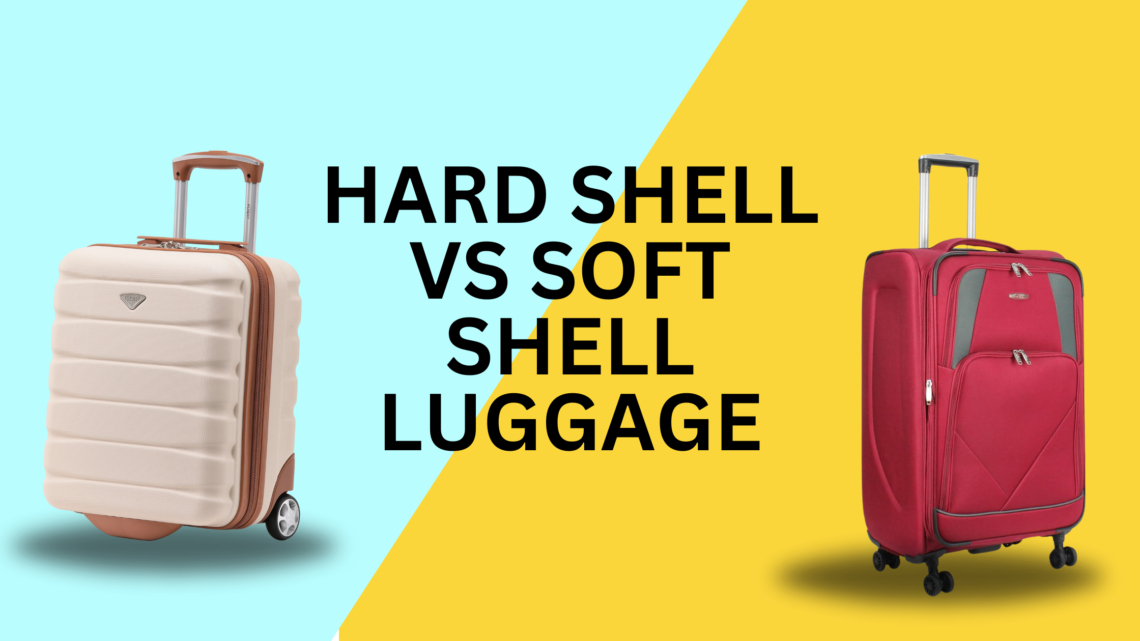
Hard Shell vs Soft Shell Luggage: Choosing the Right Suitcase for Your Travels
When packing for a trip, choosing the right type of luggage is crucial for a hassle-free travel experience. Hard shell and soft shell suitcases each offer unique benefits and can cater to different travel needs and preferences. We often find ourselves weighing the pros and cons of both options, considering factors such as durability, protection, and convenience.
Hard shell luggage typically features a rigid exterior made from materials like polycarbonate or ABS plastic, offering superior protection against impacts. This makes them an ideal choice for travellers who carry delicate items or frequently travel with airlines that may handle baggage roughly. On the other hand, soft shell suitcases are constructed from fabrics such as nylon or polyester, permitting a degree of flexibility and the potential for extra packing space due to their expandable sides.
Considering functionality, hard shell cases are often more water-resistant and easier to clean, while soft shell luggage can offer more external pockets for easy access to travel essentials. The decision between the two styles hinges on personal travel habits, the nature of the items being transported, and the various destinations one might visit.
Best Soft shell Suitcase
Best Matching Suitcase Set
Best Hard Shell Medium Suitcase
No products found.
Key Takeaways
- Hard shell and soft shell luggage serve different travel needs, with hard shells providing better protection and soft shells offering flexibility.
- Material choices for each type of luggage carry implications for durability and practicality during travel.
- Luggage selection is influenced by packing preferences, destination considerations, and maintenance requirements.
Distinguishing Hard Shell and Soft Shell Luggage
Hard-shell luggage is typically manufactured from materials like polycarbonate or ABS (Acrylonitrile-Butadiene-Styrene), known for their robustness. These materials allow the luggage to offer enhanced protection against impacts. Hard-shell cases are recognised for their sleek appearance and usually have a rigid structure.
Soft-shell luggage, on the other hand, is crafted from fabrics that offer flexibility, such as nylon or polyester. These materials enable the soft-sided bags to expand, providing more storage space and versatility. Soft-sided luggage can also have external pockets for additional compartments.

Now that we have gained a comprehensive understanding of the dissimilarities between hard-shell and soft-shell baggage, we must ponder upon the most crucial inquiry that needs to be resolved. What is the most suitable type of luggage for our specific travel needs, considering the type of journey we are embarking upon, the duration of our trip, and the nature of the items we are carrying?
- Superior protection for contents, especially against harsh impacts.
- Generally more water-resistant than soft-shell luggage.
- Less flexible, which may result in fewer options for overpacking.
- Typically has fewer outside pockets, limiting quick access to travel essentials.
- Offers more flexibility with expandable options and outside compartments.
- Often lighter in weight, making it easier to handle and maneuver.
- Possible lower level of protection for fragile items.
- Can be less resistant to abrasion and tears compared to hard-shell counterparts.
In terms of durability, both types can be long-lasting, depending on the quality of the material and construction. However, hard-shell cases may show scuffs and scratches more visibly.
When it comes to price, soft-sided options are often more affordable, though this can vary on the basis of brand, quality, and design features. Weight can also be a deciding factor; hard-shell luggage used to be heavier, but advancements in materials have led to lighter designs competing with soft-shell variants.
Design and Material Considerations
In evaluating luggage, we consider the materials used, their aesthetic impact, and how these factors influence weight and mobility.
Materials Used in Luggage Construction
Hard-shell Luggage: Often crafted from materials like polycarbonate, ABS (Acrylonitrile Butadiene Styrene), and aluminium.
- Polycarbonate is celebrated for its resilience and capacity to withstand pressure without cracking.
- Aluminium offers high-end durability with a metallic aesthetic but can be heavier.
- ABS is typically more cost-effective, though it may not offer the same level of durability as polycarbonate.
Soft-sided Luggage: Usually made from fabrics such as Cordura, ballistic nylon, or ripstop nylon.
- Cordura is known for its durability and resistance to abrasions.
- Ballistic nylon boasts high tensile strength, ensuring protectiveness.
- Ripstop reinforces to prevent tears from spreading.
Suitcase Aesthetics and Style
- Our luggage’s style is shaped by the selected material, colour, and design elements.
- Hard-shell suitcases can display a sleek and modern look, with a glossy or matte finish.
- Soft-sided cases present a classic appeal and are often complemented with multiple pockets and compartments.
Weight and Mobility Factors
- We assess the weight and how it affects the traveller’s experience.
- Hard-shell luggage tends to be heavier than soft-sided due to the denser materials used.
- Corner guards and sturdy handles add to the luggage’s weight but also contribute to the overall sturdiness and ease of mobility.
- Lighter luggage facilitates better mobility, less strain during travel, and often adheres to airline weight restrictions more efficiently.
Functional Attributes
Before we discuss the differences between hard shell and soft shell luggage, it’s essential to understand how their various features can affect functionality in terms of security, storage options, and durability.
Security Features
- Hard-shell suitcases typically offer better protection with integrated locks and less prone exteriors to tampering due to rigid construction.
- Soft luggage often has more exterior pockets but may be less secure as zippers on these pockets can be more easily compromised.
Storage and Compartments
- Compartments: Soft luggage usually boasts multiple exterior pockets, increasing organisation but potentially decreasing security.
- Expandability: Many soft suitcases have an expandable option, allowing for more packing space when needed.
| – | Hard-Shell | Soft Luggage |
|---|---|---|
| Exterior Pockets | Rarely available | Frequently featured |
| Interior Compartments | Fixed | Variable with additional expandability |
Durability and Resistance to Damage
- Wear and Tear: Soft luggage can be more prone to tears or rips, while hard-shell exteriors resist punctures but can scratch or crack under heavy stress.
- Material Resistance:
- Hard shells are often made from polycarbonate or ABS, offering water-resistant qualities and protection from the elements.
- Soft luggage is typically fabricated from fabrics like nylon or polyester, which can vary in water resistance and overall durability.
We find that manoeuvrability is key, and both types of luggage provide spinner wheels for excellent control and ease of movement through various travel situations. The choice between hard-shell and soft-shell luggage ultimately depends on these functional attributes and personal preferences regarding security, storage needs, and durability requirements.
Travel and Packing Considerations
When considering luggage for travel, we must evaluate how the choice between hard shell and soft shell impacts our journey and packing approach.
Suitability for Types of Travel
- Hard Shell Suitcases: Ideal for:
- Air Travel: Offers better protection against impacts and rough handling.
- Adverse Weather Conditions: Provides resistance to water and humidity.
- Soft Shell Luggage: Suited for:
- Road Trips and Train Travel: More forgiving in size, can be squeezed into tight spaces.
- Short Trips: Lightweight, easier to manoeuvre through crowded areas.
Packing Space and Organisation
Packing Space:
Hard Shell:
- Usually offers a fixed amount of space.
- Some feature an expandable zipper for additional space.
Soft Shell:
- Often more forgiving if we need to overpack slightly.
- Exterior pockets offer extra space and easy access.
Organisation:
Hard Shell:
- Often designed with two equal halves of the main compartment.
- Less interior compartments, which can require more strategic packing.
Soft Shell:
- Typically come with multiple interior compartments.
- Helpful for separating items and accessing them conveniently.
Our choice should reflect our specific needs and preferences, factoring in the balance between the need to compress items securely and the desire for quick access to our belongings.
You May Also Like

What Are Virgin Atlantic Baggage Allowance Guidelines for 2024 Flyers?
April 26, 2024
What are EasyJet Baggage Allowance Rules: Quick Guide to Luggage Policies
May 10, 2024
